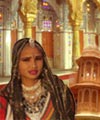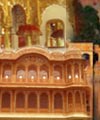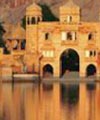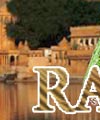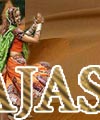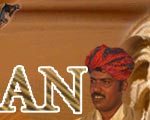|
Excursion Of Jaipur
Jaigarh Fort
The
imposing fort, built in 1726 by Jai Singh was opened tot he public
in mid - 1983 and offers a greatviewover the plains from the Diwa
Burj watchtower.
The fort served as the treasury of the Kachcawas. It is a remarkable
feat of millitary architechture in a fine state of preservation,
with water reservoirs, residential areas, a puppet theatre and worl
largest wheeled cannon, Jaya Vana.
Jaigarh was never captured and is therefore in a pretty good shape.
A giant mounted cannon-the Jai Ban, one of the largest in the country
are preserved here. The extensive parkotas (wallls), watch tower
and gateways of Jaigarh dominate the western skyline.
Govind Dev Ji
The most popular temple of Jaipur dedicated to Lord Krishna. It
is located in the central pavilion of the Jai Niwas Garden to the
north of Chandra Mahal. The image of the patron deity-Govind Devji,originally
installed in a temple of Vrindavan, was reinstalled here by Sawai
Jai Singh II as his family deity.
A Part of City Palace complex, this Krishna Temple is highly revered
by the erstwhile royal family. The image brought from Vrindavan,
is housed within the sanctum of this spireless temple, the patron
deity of the royal family is very religiously worshipped by most
of the Hindus in the city and near by areas. The image is unveiled
seven times daily for 'AARTIES' and BHOGS offered in the silver
wares, consisting of sweets mostly. The idols of RADHA KRISHNA are
dressed in different styles each time for the 'AARTI' procession
where thousands of followers or 'Bhakt' gather around the courtyard
for the Darshan (a look connecting them with the divine).
Swargasuli
The highest tower dominating the skyline of the western side of
the Tripolia Bazaar. It was built by Sawai Ishwari Singh in 1749
A.D. to commemorate a grand victory.
Also known as the Israr Lat, this tower was irected in the mid
- 18 century by Maharaja Ishwari Singh to commemorate a
battle victory. Ironically, Ishwari Singh was ostracised for his
love of a common girl, and he is the only Kachcawaha maharaja who
has not been commemorated at Gaitore.
Sisodia Rani Garden
Six kilometers from the city on Agre road, this palace with its
surrounding terraced gardens was built for Maharaja Jai Singh's
second wife, the Sisodia princess. The palace is closed but the
outer walls are decorated with murals depicting hunting scenes and
the Krishna Legend. Video cameras are not permitted.
BM Birla Planetarium
The Birla Planetarium is at the BM Birla Science & Technology
Center, near Statue Circle. The Planetarium offers unique audio-visual
educational and entertainment with its modern computerised projections
system.
This attractive building houses a state-of-the-art centre of knowledge
on the cosmos and a unique science and technology museum with several
self-operated models.
Galta Ji
An ancient pilgrimage centre, lying beyond the gardens amidst low
hills.Temples ,pavilions and holy kunds (natural spring and reservoirs)
along with lush landscape make it a delightful spot. The small temple
of the Sun god, built by Diwan Kriparam on the top of the highest
peak is visible from all parts of the city.
A popular site with pilgrims, Galtaji's hilly location is full
of surprising spires and peaks. Some of the temples here are quite
old, and a sun temple is perched atop the highest point. The natural
springs here are said to possess curative properties. The legend
is that Galtaji was the place where the sage Galava performed penance
15 centuries ago. Top
Old City
It’s called ‘The Pink City’. Simply because the
city is colored pink! Jaipur offers myriad colors for the visitor
- in the bright vibrant traditional skirts of the Rajasthani women
and in the huge turbans of the men folk. And of course
there are the long rows of shops selling traditional handicrafts,
trinkets, silverware, the works!
The great warrior King Maharaja Sawai Jai Singh II established
the city in the 1720s. He was the quintessential ruler, warrior,statesman,
mathematician, astronomer and architect, the last of which is quite
evident in the impressive plan and layout of the old city. The broad,
open lanes and rectangular road intersections are evident in the
Johari (jeweler) Bazaar in the old city. Unlike many of the cramped
markets elsewhere in the country, this one is different in that
it is planned to enable a smooth flow of traffic. The old city is
also host to a number of other markets like Bapu Bazaar, Tripolia,
and Chandpol Bazaar. Here you can buy cotton fabrics, camel skin
jutties (slippers with the unique upturned toes) and ittars (traditional
perfume).
Once a settlement of nobles,craftsmen and common folks, the city
of Amer is now in ruins. The remanants of its rich past are the
beautifully carved and planned Jagat Shiromani Temple, a Krishna
temple associated with Meerabai, an ancient temple of Narsinghji
and a magnificent step-well,Panna Mian-ka-kund
Ram Niwas Bagh
A garden planned by Maharaja Ram Sigh in the 19th century as a famine
relief project, this extensive park consists of a zoo,aviary, herbarium,
museum and sports complex. An added attraction is the Albert Hall,
designed by Sir sSwinton Jacob, a British architect who created
palaces for many rulers in Rajasthan. The Hall is home to an exquisite
collection of sculptures, paintings, objects d’art, natural
history specimens, an Egyptian mummy and a beautiful Persian carpet.
Recently, the Rabindra Manch with an auditorium, a modern art gallery
and an open-air theatre, has been added to promote cultural events.
Karauli
Located at 182 kms southwest of Jaipur, it was founded in 1348 and
is best known for its Krishna Temples. The Fort, which was constructed
over different period, is about 600 years old. The fort was the
residence for the royal family until 1950 and is now occupied by
monkeys and geese. The geese were used in the early days as warningsystem
against any intruders. They still seem to be doing their duty. The
Bhawar Vilas Palace, which is owned by the descendents of the royal
family and resembles a large manor, is a hotel now. The rooms are
comfortable and good meals are available. Karauli is best connected
by bus or taxi from Jaipur.
Jain Temple
The most beautiful temple in Sanganer is the ancient Shri Digamber
Jain temple. The temple has fine carvings as those of the magnificent
Dilwara temples of Mount Abu. Built in various phases with sky-high
shikharas (spires), the temple represents an old style of architecture.
The last phase was probably built in the 10th century. The beautiful
nij-mandir (inner temple) is a stone shrine with three pinnacles.
In the centre is an idol of Parshwanath with 7 serpent hoods. All
around it, are carvings of lotuses, creepers and elephants pouring
water from pitchers held in their trunks. But the main idol is that
of Adinath, installed in the shrine behind this.
Moti Dungri
A small palace, this is a replica of a Scottish castle, and perches
on a hilltop. Once occupied by Maharaja Madho Singh's son who was
confined here, it was also for a while home to Maharani Gayatri
Devi. Entry is prohibited.
At the foot of Moti dungri fort is the Birla Lakshmi Narayan Temple.
It is a large, modern marble edifice. Stained glass widows depict
the scenes from Hindu scriptures. Ganesh the protector of households,
is above the lintel, and the fine quality of marble is evident when
you enter the temple and look back at the entrance way - Ganesh
can be made out through the marble, which is almost transparent.
The images of Lakshmi and Narayan were carved from one piece of
marble. Many of the deities of the Hindu pantheon are depicted inside
the temple, and on the outside walls great historical personages
and figures from all religions are shown, including Socrates, Zarathustra,
Christ, Budhda, and Confucius.
Top
Kanak Vrindavan
Complex
Not so old but definitely an exquisitely land scaped gardens with
beautifully carved temple in beige stone, which is a vast complex
with terrace sites all around and intricately carved marble columns
and lattices. Located in the foothills of Nahargarh hills on the
way towards Amer, this complex is a popular spot for picnic and
film shoots. It should be definitely visited on the way to the three
garland forts of Jaipur- Nahargarh, Jaigarh and Amber. The greenery
after the monsoons give this whole place a feel of heavenly sensation,
with Jal Mahal in the background.
Samode
the Nathawat family of Samode served as prime ministers in Jaipur
court, and their four-century-old fortified residence some 40 km
from Jaipur is able to exibit the good taste learned at royal palaces
in a more restrained space. The Durbar hall at Samode Palace is
one of the most beautifully painted chambers in Rajasthan. Close
by is the samode bagh, the garden pavelion with charming water channels
and ancient trees. In Jaipur itself, the family built itself a townhouse,
samode haveli. which typifies the style of architechture then in
prevalance, including accessible public spaces, especially for the
women of the family. The paintings at the Haveli are every bit as
excellent as at the Palace, if a little less profuse. All three
properties are hotels.
Bagru
Bagru, a small village town in Rajasthan, is a centuries old centre
for hand block printed textiles.
It is located 30 kms away from Jaipur on the Ajmer Road and is
well known for its Bagru prints. This technique simulates a wooden
block on which the required design is first carved, then the carved
block is used for transferring the motif in the desired colour on
the fabric. This process is most effective on ethnic floral patterns
and for printing in vegetable dyes in traditional Bagru Prints.
The Bagru prints are include less range of colors which are usually
deep and dark shades. The beautiful designs, easy designing process
and use of natural colors have made Bagru prints very important
in Rajasthan's Block printing. Also, Bagru prints are very famous
among the traditional look of the wear and ethnic taste of the furnishings.
Ramgarh Lake
A huge artificial lake created by constructing a high bund amidst
tree covered hills. While the temple of Jamwa Mata and the ruins
of the old fort are some of its antiquities, its beautiful landscape,
especially during monsoons, makes it an idyllic picnic spot.
Bairat
The site
of Bairat is located on Alwar Jaipur highway - about 66 kms. from
Jaipur and 40 kms. from Alwar town. The site has got two inscriptions
of Mauryan king Ashoka, one on an isolated boulder and other on
a hill also known as Bijak - ki - Pahari. A roughly
flagged ramp takes you to the top of this hill. One of the inscription
is addressed to the Buddhist community. The Buddhist remains are
located on the two terraces on the Bijak - ki - pahari,
the upper terrace with a brick masonary and the lower one with a
brick sanctuary. The sanctuary is a circular stupa with a door in
the east, enclosing another circular wall of wedge - shaped bricks.
The intervening space serves as a procession path of circumbulatory
passage.
The upper terrace of the hill is approached by a broad staircase
and has dilapidated monastery. There were evidences that monastery
continued from Mauryan period till early Christian era with discovery
of 36 silver punch marked Greek and Indo - Greek coins from
the monastery.
The Bairat was flourishing Buddhist centre during the 4th and 3rd
century B.C. under the Mauryan king Ashoka which was attested by
his two inscription fragments. One or more pillars of Ashoka in
Chunar sandstone and a polished stone umbrella of Mauryan craftsmanship
were found in the debris. The site remained in occupation till early
centuries of the Christian era and after a break, in medieval period.
Top
Abhaneri
About 95 km from jaipur on the Agra road , this village has one
of theRajasthan's most awesome baories(step-wells) and is well worth
a detour if your are travelling this way. Flanking by mammoth baoriis
a small crumbuling place, now inhabited by pegions and bats. In
recent yeaers the water level has dorpped low enough to reveal 13
levels of steps down to the stagnant water of the baori, but there
are beleived to be even more levels beneath that. You are allowed
to take the photos of the baori but not the statues.
Sambhar
Sambhar is 190 sq. km in extent at full capacity, and lies some
60 km west of Jaipur, just outside prosaically named Salt Lake City.
This vast body of glacial saline is on average just 0.6 cm deep
and never more than 3 m even just after the monsoon. It stretches
in length for 22.5 km, its width varying between around 3 and 11
km. It is fed by several seasonal fresh water streams, two of the
major ones being the rivers Mendha and Rupangarh.
Sambhar quite literally means salt, and salt has been extracted
from here for over a thousand years by the various administrators
of the area . Over time, these have included the Scindhias, Rajputs,
Marathas, Moghuls and the rulers of Jaipur and Jodhpur who jointly
owned the lake, and who in 1870 leased it to the British who built
the solid square Circuit House where we were fortunate enough to
stay.
After independence, the lake was taken over by the government and
is now managed by Sambhar Salts Limited, a joint venture of Hindustan
Salts and the Government of Rajasthan.
The vast, roughly elliptically shaped lake has been divided into
two sections by a 5 km long stone dam. The eastern section contains
the reservoirs for salt extraction, canals and salt pans. Water
from the vast shimmering western section is pumped to the other
side via sluice gates when it reaches a degree of salinity considered
optimal for salt extraction.
The waters here are glacially still, edged with a glittering frost
of salt. Files abound, drawn by the blue-green algae in the water
and queue up in order to crawl into your mouth and ears. There is
a sharp briny tang in the air taking you straight back to coastal
fishmarkets. The only thing missing being the hushing lisp of the
sea as it fans out on the beach.
Madhogarh
& Tunga
Tunga was witness to a historic battle fought between the Jaipur
forces and Marathas. The fort is nestled amidst beautiful mango
orchards.
The Present owner, Thakur Bhawani Singh, the fourth generation
directed descendent of Thakur Pratap Singhji, has now renovated
the Madhogarh Fort and converted into a family run heritage hotel.
Guests can now experience the famous Rajput hospitality and relive
the glory of a bygone age.
Nahargarh Tiger Fort
Nahargarh (tiger Fort), overlooks the city of Jaipur from a sheer
ridge to the north and is floodlit at night. The fort was built
in 1734 by Jai Singh and extended in 1868. A 9 km road runs up through
the hills from Jaipur, and the fort can be reached along a zigzagging
2km path which starts from the north - west of the old city. The
glorious view fully justify the effort. Inside the fort you can
visit the Madhavendra Bhavan housing the nine apartments of Maharaja
Ram Singh's nine wive. The rooms are linked by a maze of corridors
and retain some delicate frescoes, as well as toilets and kitchen
herths.
Top
Information on Tours & Travel excursion of Jaipur - india
|
